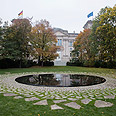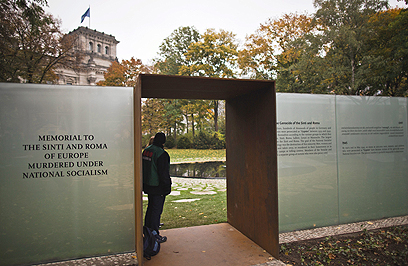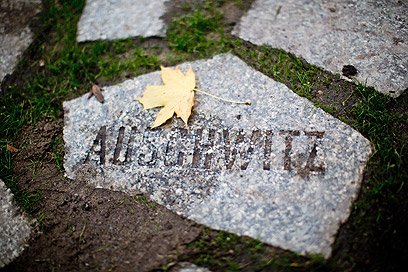

ChancellorAngela Merkel and President Joachim Gauck inaugurated the memorial at an official ceremony in Berlin's Tiergarten Park. Designed by Israeli artist Dani Karavan, it features a water-filled basin with a retractable, triangle-shaped column at its center that will be topped by a fresh flower every day.
Related stories:
- Gypsies seek recognition at Holocaust conference
- Germany: Convicted SS soldiers released
- Amazon blasted over Nazi camp puzzle
Panels detailing the Nazis' persecution of the minority surround the memorial, which is located across the road from the Reichstag, Germany's Parliament building, and close to memorials to the Nazis' Jewish and gay victims that have been inaugurated in recent years.
Gypsies were subjected to racial discrimination from the early days of Nazi rule. Before Berlin hosted the 1936 Olympic Games, hundreds were rounded up and interned; and in 1938, SS chief Heinrich Himmler set up a central office for the persecution of Gypsies – also known as Sinti and Roma.

Water-filled basin at Tiergarten Park (Photo: AP)
It is not clear exactly how many Gypsies were killed during the Holocaust. Estimates range from 220,000 to more than 500,000.
Their fate drew little attention as post-World War II Germany began to come to terms with the Nazis' crimes, primarily focusing on the slaughter of some six million Jews.
Only in 1982 did West German Chancellor Helmut Schmidt publicly declare that Sinti and Roma "were persecuted for reasons of race. These crimes constituted an act of genocide."

Karavan shakes camp survivor's hand during ceremony (Photo: AFP)
Plans to build the Berlin memorial go back to 1992, though the project was delayed by disputes over the design and other matters.
"Unfortunately it is too late now for many survivors of the Nazi terror," said Zoni Weisz, a Gypsy who recalled escaping deportation to Auschwitz from the Westerbork transit camp in the Netherlands in 1944, at age 7, with the help of a policeman.
"But for the few who can see this today, and for their families, this memorial is in my eyes a kind of redress," he said at the inauguration ceremony. Weisz's mother and two younger siblings were killed at the Auschwitz death camp.

Entrance to memorial. 'A kind of redress' (Photo: EPA)
The head of Germany's Central Council of Sinti and Roma, Romani Rose, said the new memorial embodies the need to fight anti-Gypsy prejudice in the same way as anti-Semitism.
"In Germany and in Europe, there is a new and increasingly violent racism against Sinti and Roma," he said. "This racism is supported not just by far-right parties and groups; it finds more and more backing in the middle of society."
The minority faces discrimination in Europe's ex-communist east and elsewhere on the continent. In August, police raids in Paris and other French cities dismantled camps used by Roma from Eastern Europe and left hundreds without shelter.
Weisz said that "society has learned nothing, almost nothing – otherwise we would be treated in a different way now."
"I hope that, with the inauguration of this memorial, what I call the forgotten Holocaust will no longer be forgotten and will get the attention it deserves," he added.

Names of massacre sites egraved on rocks (Photo: EPA)
Merkel stressed the need to protect minorities, which she said "enrich the diversity of Germany."
"Let's not beat about the bush – Sinti and Roma often suffer from marginalization, from rejection ... Sinti and Roma have to fight for their rights even today," she said. "So it is a German and European duty to help them in this, wherever and within whatever country's borders they live."
The Gypsy memorial's opening follows the unveiling in 2005 of Berlin's memorial to the six million Jews killed in the Holocaust, a vast field of concrete slabs; and the inauguration in 2008 of the memorial to the long-ignored gay victims of the Nazi regime.
A further memorial is planned to victims of the Nazi program of euthanasia of the mentally ill and others deemed "unworthy of life."
- Follow Ynetnews on Facebook and Twitter
- Receive Ynetnews updates
directly to your desktop















